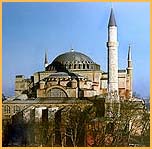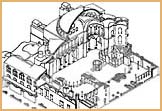Majestically dominating the easternmost hill of Constantinople, the religious and political hub of the Empire,
 Hagia (Saint) Sophia is the most perfect creation of Byzantine church building and one of the
most important monuments of world architecture. Every Byzantine
emperor of any importance has associated his name with the history of the
monument.
Hagia (Saint) Sophia is the most perfect creation of Byzantine church building and one of the
most important monuments of world architecture. Every Byzantine
emperor of any importance has associated his name with the history of the
monument.Dedicated to Divine Wisdom, the original church was built by Constantine the Great. Yet, it was soon to be destroyed by fire, in 404. It was rebuilt by Theodosios II in 415, before it was burnt in the Nika revolt in 532. On February 23 of the same year building began anew, following an ambitions architectural design conceived by Anthemios from Tralleis and Isidoros from Miletos, the two architects selected by Justinian. The emperor himself oversaw the construction works, which lasted five years. It was consecrated on December 21, 537, and Justinian is reported by contemporary sources to have exclaimed: 'I have defeated thee, Solomon!'  The
individuality of the monument lies in its original architectural design, which
ingeniously creates an immense building while still preserving harmony and
balance in its mass. A few figures might give a better idea of its size: the distance from the main church entrance to the apse is approximately 80 metres and
the height up to the top of the dome 62 metres. The
individuality of the monument lies in its original architectural design, which
ingeniously creates an immense building while still preserving harmony and
balance in its mass. A few figures might give a better idea of its size: the distance from the main church entrance to the apse is approximately 80 metres and
the height up to the top of the dome 62 metres.An original feature of the design and a real achievement at the time was the roofing of the church by a huge dome (13.8 metres high, 32 metres in diameter), which rests on two half-barrel vaults east and west, shaped like a quarter of a sphere each, and two large arches on the north and south sides. Forty windows perforate its base, giving the impression that the dome is not part of the building but hangs like a golden sphere from heaven, as Procopios characteristically put it. |
|